Table of Contents
Keyword research (keyword analysis) is fundamental in SEO, as it forms the basis of search engine optimization. We’ll show you what keywords are and what properties they have. We will also explain how to conduct keyword research, what should be considered, and which tools are helpful. This way, you will be well prepared if you want to carry out keyword research.
What is a keyword?
A keyword is a search term that people search on Google or other search engines. A keyword consists of all the words that can be entered into a search engine or search field. For example, if you enter “SEO agency” in the Google search, the keyword is SEO agency!
A keyword consists not just of one word but the entire number of words in the search query!
Why is SEO keyword research important?
In search engine optimization, keyword research is the cornerstone of on-page optimization. From this important document, the direction of SEO optimization emerges. Therefore, keyword research should be carried out thoroughly, as even small mistakes and inattention can have a big impact. Keyword research also helps you understand your target group’s fears, concerns, and problems. Specific content can then be created for this purpose.
Characteristics of SEO Keywords
Keywords can have different properties. We will show you which keyword properties are important in search engine optimization.
Word count
A keyword can consist of several individual words, and the number of words in a keyword is a strong differentiator. Here, we are talking about long-tail, mid-tail, and short-tail keywords.
- Long-tail keywords are very specific, usually have a lower search volume, have a low level of competition, and consist of more than three words.
- Short-tail keywords are generic, usually have a large search volume, and consist of one to two words. Due to the high search volume, short-tail keywords often have high competition.
- Mid-tail keywords are a mix of long-tail and short-tail keywords. They are slightly specific and have a moderate search volume and intense competition.
Here is an example of keywords in different lengths:
| Length of the keyword | Keyword | Search volume | KD |
|---|---|---|---|
| Short tail keyword | “Agency” | 4,400 | 70% |
| Mid-tail keyword | “SEO Agency” | 1,000 | 63% |
| Long tail keyword | “SEO Agency in Lahore” | 480 | 49% |
Search volume
Different keywords have different search volumes, which means they are searched for at different frequencies. This describes the search volume for the respective keyword. Search volume shows how frequently a particular keyword is searched for. Most often, the search volume per keyword per month is displayed.
You also need to know: How many keywords should a page have to rank well?
Input format
Search terms can be entered and spoken using Siri, Alexa, Google Assistant, and Co.! Natural Language Processing (NLP) analyzes vocal speech input, reproduces it in text, and searches the Internet using keywords. Keywords based on voice input are called Natural Language Query (NLQ). These usually have more words, as search terms on the keyboard are usually only formulated in keywords (yes, some people still type the entire sentence).
Spoken searches are becoming increasingly important as more people use Siri, Alexa, and Google Assistant to place orders. According to statistics on NLP sales, it is expected to almost double to $43 million from 2022 to 2025. Based on this statistical forecast, it can be assumed that NLQs will become increasingly important in search engine marketing in the future.
Search intention
If tools like Sistrix are used for keyword research, the search intent behind the query is usually considered. However, it would help if you questioned your tools because search intent can change over time. The search intent for “jaguar” can refer to the animal or the car brand. Search terms often do not have a clear search intent because different users with different search intent enter the same keywords. The dominant interpretation of the search intent then determines the search intent of the respective keyword. Search intentions are divided into five categories:
- Do ( transactional intentions ): This is what we are talking about when users make contact requests after a free download, such as a white paper, and thus trigger a transaction. Example: “SEO checklist” and “ophthalmologist appointment.”
- Know ( informational intentions ): The user wants to receive information, facts, data, or knowledge. Search intentions for Know Simple usually contain short and easy answers. Example Know: “Care for cast iron pan.” Example Know Simple: “inhabitants of Pakistan” and “speed leopard.”
- Website ( navigational intentions ): The search intention is navigational when users do not know the company’s domain but want to get to the website or when a Google search with short-tail keywords leads to the desired website faster than typing in the URL. Examples: “Citrix login” and “gmail”.
- Commercial intentions: Before users make purchases online, commercial research begins. You want to inform yourself and not buy a pig in a poke. This is why it is called commercial user intent. Examples: “best full format camera.” Commercial intentions can be divided into know and do commercial.
- Visit-in-person ( local intentions ): Local intentions suggest that users are looking for specific companies, organizations, or services in their area: “chicken tikka Lahore” and “nearest gas station.”
Search intentions can be further segmented according to their category. A little insight into this is in the following table.
| User Intent | Keyword example | Buy a full-frame camera. |
|---|---|---|
| do | The user most likely wants… | a list of SEO measures to check off. |
| Do Commercial | “buy full frame camera” | Buy a full frame camera. |
| Know | “SEO checklist” | Get general information about SEO. |
| Know Simple | “Size of Tom Brady” | Know Tom Brady’s height. |
| Know Commercial | “smartphone comparison” | inform before purchase. |
| KnowNews | “Ukraine-Russia Conflict” | Obtained information about the Ukraine-Russia war. |
| website | “Reddit login” | Log in to Reddit. |
| Visit in person | “chicken tikka Lahore” | Locations of restaurants in Lahore that offer chicken tikka. |
Which tool do I use for SEO keyword research?
The best tool you can use is your brain! But more on that later. The many tools on the market are very helpful, but they only have a supportive effect. When choosing a tool for your keyword research, it depends on how exactly the search volume for your keywords should be, which functions you want to use, and what budget you have available.
Some paid tools offer limited daily requests and usually have a better database than free tools. However, these cannot be compared with the scope of paid ones. You can also use the suggested functions of various search engines. We will introduce you to the most important suggested functions and paid and free tools. This means you are well-informed and can work with SEO tools that meet your needs.
Suggest functions
A suggest function provides suggestions for completing the search query using previously typed words. You can use these functions anywhere a search query can be entered. Here, we present some suggestions using the keyword “yoga mat” as an example. When doing keyword research, suggest functions help you get a rough overview of search terms and topics.
Google’s Suggest function usually provides relevant keyword suggestions. This example shows that users are interested in certain properties, such as the slip resistance of a yoga mat. Test results, as well as the material and sustainability, seem to be just as important. Google Suggest suggests keywords such as “price,” “near me,” “miniso” and “Lahore.”

Once the first keyword ideas have been collected, they can be supplemented with similar search queries at the bottom of the SERPs.

YouTube
YouTube‘s autocomplete delivers some of the same results as Google, but also provides completely new suggestions. Because users look for different content on different platforms. YouTube is very popular for tutorials, influencer marketing, and product reviews, which is where suggestions such as “price”, “review” and “workout” come from.
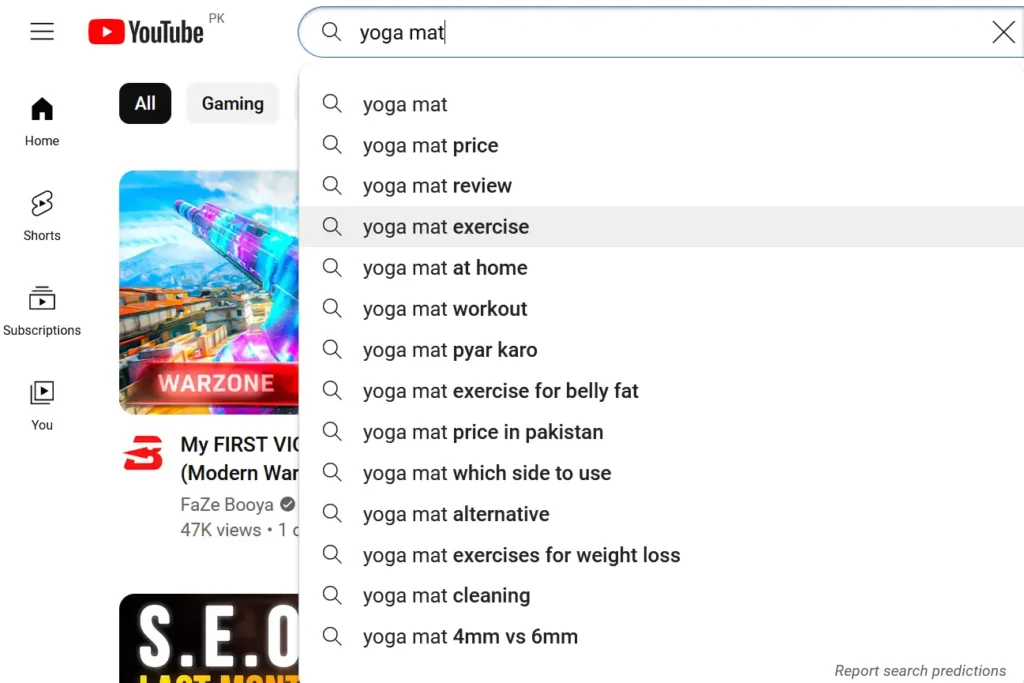
Amazon
At the large online retailer, the automatic completion is heavily based on the search intent Do Commercial or Know Commercial. Amazon’s suggest function is particularly useful for keywords that describe a physical product and are suitable for online shopping.

Free keyword research tools
Due to a large number of free tools, it is easy to lose track and have a harder time assessing which tools are most suitable for your purpose. We will therefore introduce you to the most useful and free tools so that you can better decide which of the free tools are suitable for you.
AnswerThePublic
A useful tool for identifying relevant W-questions is AnswerThePublic. Currently, 3 requests can be made per day, in different languages.
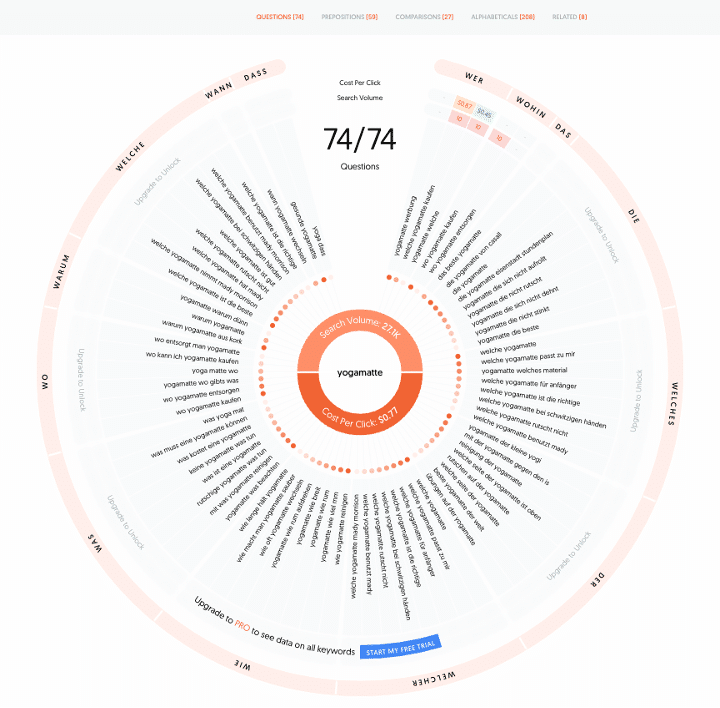
Advantages:
- Free of charge
- Keywords are ordered alphabetically
- Clusters of keywords
- Keywords are easily manageable through alphabetical order, W-questions & preposition clustering in combination with the keyword
- Lots of languages to choose from
- Zoom function (helpful for large diagrams)
Disadvantages:
- Only 3 requests per day in the free version
- Filter function and download of the results are only possible with the Pro version.
- Some inaccurate and irrelevant keywords, especially for long-tail keywords
AlsoAsked
Alsoasked is also a useful tool for finding relevant W-questions. Compared to AnswerThePublic, the keywords or W-questions are displayed here in a tree diagram.
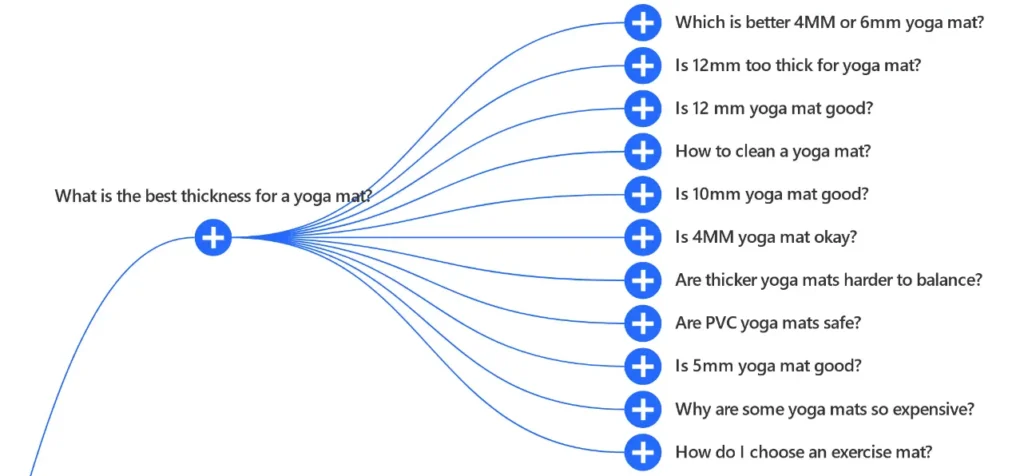
Advantages:
- Free of charge
- Visually easy-to-understand representation
- Extensive language selection
Disadvantages:
- Only 3 requests per day are possible in the free version
- Subsequent branches of the tree diagram are often not thematically related to the previous branch
- Sometimes it delivers a lot of irrelevant keywords
Google Trends
The Google trend tool can be used to visualize trend forecasts over a certain period by region. This can help you better identify seasonal trends and include them in your keyword research.

Advantages:
- For free
- Graphical overview of the search history of a keyword over a certain period
- Geographically scalable
- Provides related topics
- Comparison of several keywords possible
Disadvantages:
- Not absolute numbers, but relations
Keyword sheeter
Keyword Sheeter tool delivers tons of keywords! In order not to lose track, it is recommended to use the positive filter and negative filter functions. This way you avoid having to invest too much time sorting out irrelevant keywords later.
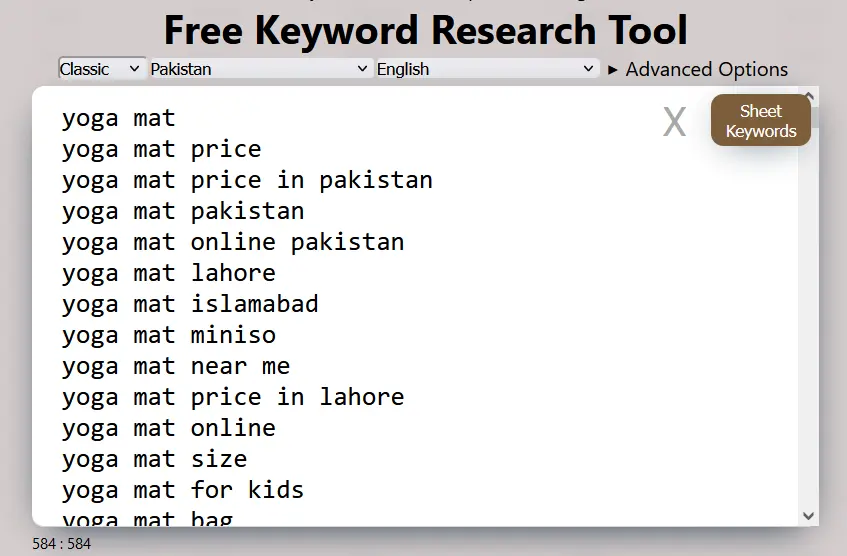
Advantages:
- For free
- Filter functions
Disadvantages:
- Delivers masses of irrelevant keywords
- If the filter function is used incorrectly, potentials can be lost
Google Search Console
If you want to examine more closely which keywords you are already ranking for, the Google Search Console (GSC) is useful. The tool provides you with the ranking positions of the respective keywords. You can use the GSC to identify low-hanging fruit or identify keywords that require more effort to rank on the first Google page in the SERPs.

Advantages:
- Free after registration
- Provides additional data about impressions, CTR, average rankings of your keywords & error analysis
Disadvantages:
- Not suitable for beginners as error messages are not per se errors reported by the GSC.
Each of these free tools has its advantages and disadvantages; using them is advisable in most cases, but it always depends on the industry or keywords. This means that suggestion functions for services from craftsmen or agencies cannot be searched for in the Amazon search bar. Other ways to use the suggest functions depending on the industry and keyword include Instagram, Bing, Pinterest & Etsy, or in every search bar with automatic suggestions to complete the search query.
Paid keyword research tools
When it comes to keyword research, tools with extensive data sources and features are impressive, which are usually not available in free tools or are only available in a slimmed-down version. Therefore, paid tools can provide much more information about keywords, for example about keyword characteristics such as search volumes or competition intensity.
We introduce you to the best-known paid tools. This way, if you make a purchase decision, you will know which tool is right for you.
KWFinder by Mangools
The KWFinder impresses with its features and wealth of data. This not only provides keyword suggestions but also trend information about the keywords. It graphically displayed how often the respective keyword was searched for in the last 12 months. This means that seasonal fluctuations can be recognized at a glance.
The competition intensity is determined by Keyword Difficulty (KD ) indicating how difficult it is to rank for the keyword. The value is given between 0 – 100. The higher the value, the stronger the competition and therefore the more difficult it is to rank for the keyword. However, this value is only an indicator, because the Keyword Difficulty Score does not take into account Google ranking factors such as user signal & page speed, as well as page authority.

Advantages:
- Trial version for 10 days
- Clear
- Large database
- Cheaper with an annual subscription
Disadvantages:
- Uninformative keyword difficulty score
Ahrefs – Keyword Explorer
In addition to the huge backlink database, Ahrefs Tools also offers a large keyword database. Keyword research is carried out with Ahrefs via the Keyword Explorer and also provides keyword ideas. This is not available separately but comes with an Ahrefs subscription, which also allows backlink checks. The Ahrefs Explorer provides a variety of features, such as the average number of clicks in the SERPs for the searched keyword. The explorer also shows the average number of clicks in the SERPs for the searched keyword per user, the ratio of clicks on ads to organic results, and the return rate (RR). The RR shows how often the same user searches for the same keyword within 30 days.
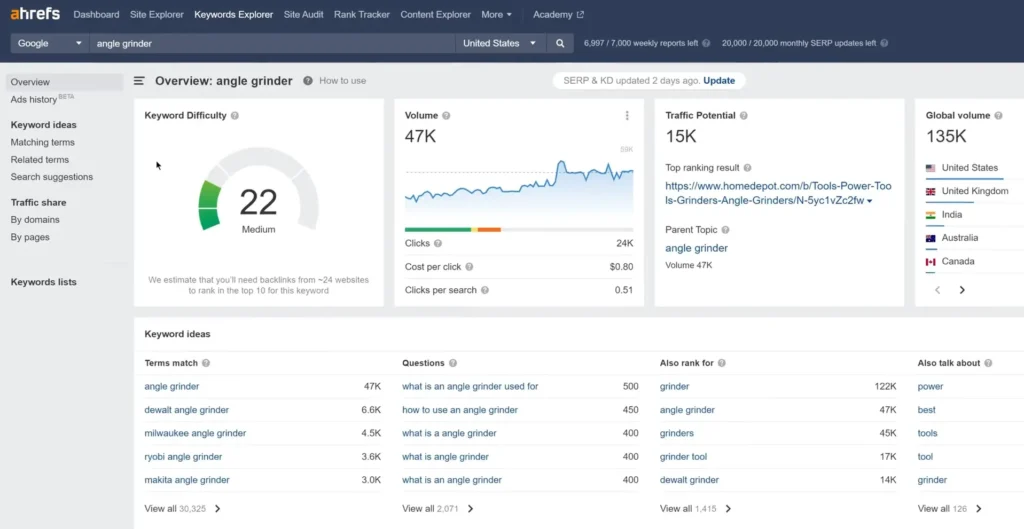
Advantages:
- Huge database for keyword research, also for backlink analysis.
- With an annual subscription, you save 2 months of premium
Disadvantages:
- No trial version
- Less intended for SEO beginners
- Expensive
- No SEO reporting function
SEMrush Keyword Magic Tools
As with Ahrefs, the Keyword Magic Tool is not available separately, but only as part of the complete SEMrush package. Therefore, the tool can be used for keyword tracking, backlink tracking, and domain analysis. The Keyword Magic Tool also classifies long-tail keywords into thematic categories, which can help understand the search intent of the users.

Advantages:
- Cheaper with an annual subscription
- Many features beyond SEO
- Trial version for 7 days
Disadvantages:
- Lots of functions so not suitable for beginners
- Low account limits
- SEMrush tries to do it all, but it’s not always the best tool for certain SEO tasks.
What do you need to consider before doing SEO keyword research?
Before you start actual SEO keyword research, there are a few things to consider. Because keyword research should of course be as effective as possible. Therefore, we present some points that need to be taken into account for thorough and professional keyword research.
Thorough research
Small mistakes or carelessness can have a big impact if relevant keywords are forgotten or ignored. As a result, the choice of focus keywords is not optimal. This means that a lot of optimization potential is lost and SEO goals are harder to achieve. It’s also frustrating when the competition leaves you behind in the rankings, despite weeks of optimization.
Know your offer
When doing keyword research, you must understand what your company offers on the market. Are there unique selling points (USPs) that can generate competitive advantages? This gives you the chance to stand out from the competition, for example, 24-hour support.
Understand the target audience
This point is often ignored when doing keyword research, but it is extremely important. Your target group may use completely different search terms for which your website is relevant, but the keywords are not optimized. Hand mixer, mixer, kitchen mixer, and cream whipper all describe the same product. Therefore, you should consider the following questions if you want to reach the right target group.
- What words, phrases, and colloquial language does your target group use?
- Who is searching for your relevant keywords? (Demographic and sociographic characteristics)
Creating personas can provide valuable insights about your target group.
Seasons
Depending on the industry, there can be different seasons. Keywords like “buy gingerbread” don’t have a high search volume until fall, but are relevant for a Christmas cookie producer. If the keywords contain words like Easter, Christmas, summer, or winter, a seasonal keyword is easily identified. In practice, however, more time usually has to be invested to identify seasonal keywords.
Customer Journey Map
The customer journey map is a modeling of all touchpoints of customers with a product, service, or brand. The customer journey model can be divided into 3 main phases (pre-purchase, transaction & post-purchase phase) and 5 sub-phases.
- Awareness: This is where awareness of a product or service is raised.
- Consideration: Also called the information phase or favoritism. Here we consider whether the product or service should be purchased.
- Conversion (implementation): After the decision has been made, the purchase is processed including delivery and, if necessary, installation.
- Retention (customer loyalty): In the post-purchase phase, your own experience is collected and partly shared through reviews, social media posts, and personal recommendations. The assessment also takes place here as to whether the experiences of others in the information phase correspond to your own.
- Advocacy: Voluntary endorsement of a product or service only takes place if there is positive retention. If customers have negative experiences, they will not be recommended.
The customer journey map is strongly linked to the search intent of the user, as users search for different keywords in the phases of the customer journey. Here are some examples:
| phase | Level | Keyword example |
|---|---|---|
| Pre-sale phase | Consideration | “yoga mat experiences” |
| Transaction phase | Conversion | “buy yoga mat” |
| Post-purchase phase | Retention | “yoga mat cork care” |
How do you conduct keyword research?
After we have reported on the prior knowledge required to carry out keyword research, we will now show you how to carry out keyword research yourself. Using the example of a fictitious real estate agent in Lahore, we will show step-by-step how keyword research in SEO works.
Provide overview
After you have already collected your first impressions of the project from the section “What do you need to consider before doing keyword research”, you have already completed the first step. Now get an overview of the real estate agent in Lahore.
- Offer: Mediation of real estate for rent and purchase.
- Service: modernization advice, advice on buying, selling, financing, criteria-based research for customers, making offers and viewing properties, and valuing properties.
- USPs: Fast same-day response time of calls and contact form, virtual tours, free checklists.
Brainstorm keyword ideas
Next, think about how you would search for the product, service, or content. This step should take place without the influence of various tools to obtain keywords that are as independent as possible.
If you have already thought about the respective target group or personas, you can better assess whether they are more likely to search for words like real estate sales house sales, or brokers and real estate agents. There is a good chance that users will search for keywords that correspond to their vocabulary. As you move along the customer journey map, you can also collect relevant keyword ideas for each phase. Not only do keywords like “buy a single-family home” are important, but also relevant keywords for a guide or blog. With Excel, you can practically write down the keyword ideas and then research the search volumes for them.
Use suggestion functions
As described in the previous chapter, the suggested functions should be used for a rough overview. Search engines like Etsy or Amazon make little sense in our example. Real estate is not advertised online and does not provide any input for keywords for the blog posts. Things are different with YouTube, here we come to some keywords that can be worth it to create content.
Clustering of keywords
Once all relevant keywords have been noted, they are clustered. When clustering keywords, relevant keywords are grouped according to search intent.
- Navigational searches
- Informational searches
- Transactional searches
By clustering the keywords, you can find out which pages you should rank for your keywords. For example, you should rank for transactional searches with product pages and informational searches with blog pages.
Also Read: How To Choose The Best Keywords For Your Articles?
For a better overview, we recommend assigning the relevant keywords that you want to rank for directly to your pages. Keyword mapping can also help avoid keyword cannibalism. This is the case when at least two URLs within a domain rank for the same keyword.
Choice of focus keyword
After mapping, the focus keywords are set for each page. Focus keywords are like the main keywords and describe the high-level content of a web page. When choosing focus keywords, don’t just pay attention to search volumes. The rule of thumb is that the more expensive a product or service, the less search volume it has. Even if only one of the 90 website visitors who search for “city villa Lahore” buys a city villa through our real estate agent from Lahore, that is a success!
Also, don’t choose too many focus keywords, because the more there are, the harder it is to get them all on the page. The focus keywords shouldn’t be too generic either. Because general keywords like “buy a house” and “real estate agent” do not specifically describe the field of activity or area of our real estate agent from Lahore. Here is the choice of focus keywords for the respective website
| Page | Focus keyword |
|---|---|
| Home page | “real estate agent Lahore” |
| Real estate site | “buy a house in Lahore”, “city villa Lahore” and “Basement apartment Lahore” |
| financing | “home loan” and “home financing” |
| counselor | “buy a house in Lahore”, “city villa Lahore” and “Basement Apartment Lahore” |
Now you know how to carry out keyword research and what you need to consider. Do you have questions about your keyword research or are you unsure how to start the actual optimization? Feel free to book an appointment with me, I’ll be happy to help you with any questions about keyword research!


